 Leading Blog | Posts by Month |
 Leading Blog | Posts by Month |
01.31.19

LeadershipNow 140: January 2019 Compilation
See more on 
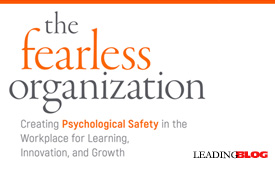
Posted by Michael McKinney at 07:38 AM
01.30.19

Newswire: 3 Leadership Lessons from Mars, Inc.’s CEO Grant Reid
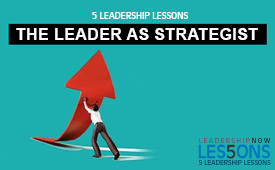 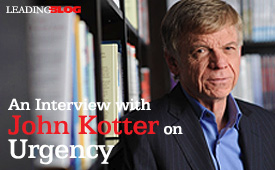
Posted by Michael McKinney at 01:54 PM
01.28.19

Return On Courage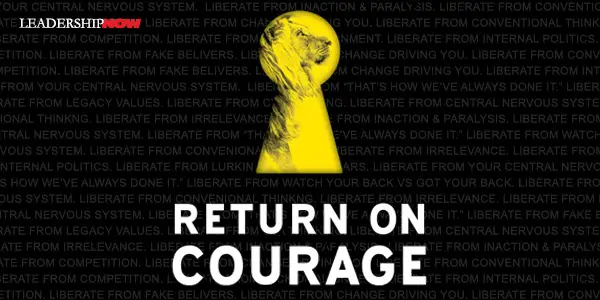
COURAGE is what gets you from here to there. But it’s not courage or risk. It’s courage and risk. They work together. “Those who are risk-averse are inadvertently courage-adverse,” says Ryan Berman author of Return on Courage. It is a balancing act. “If courage is the accelerator, then risk is the brake pedal. You need them both to drive a car, but you can’t press them at the same time or the car won’t work.” So how hard should you hit the gas? How important is it that you change? Why courage? Why now? Because companies are perishing at an alarming rate. Fifty-two percent of Fortune 500 companies from the year 2000 are now extinct. This is due primarily because the market has changed and we are afraid to do what we need to do to change with it. Qualcomm’s Roger Martin told Berman, “Everybody who’s involved in trying to resurrect what existed before, those people die…. You have to stop doing the thing that right now is making you a ton of money. You have to start shifting, and that pts the current income a risk.” And that takes courage — a lot of it. What is Courage? Berman defines courage as acquiring knowledge, building faith, and taking action. All three elements have to be present for there to be courage. Knowledge and faith without action is paralysis. Having faith and taking action without proper knowledge is reckless. Acquiring knowledge and then taking action is just not enough; it’s playing it safe. Courage is a daily decision that anyone can develop more of. It’s not a reckless action done without thinking because courage should always begin with knowledge. Central Courage System What we need is a Central Courage System. “The Central Courage System is a process that your team can repeatedly turn to for guidance. Once it has been established and implemented, you can lead with your system’s values, purpose, and point of view. The Central Courage System teaches us how to make bold, swift decisions.” The Central Courage System is represented by the acronym P.R.I.C.E.: Prioritize through Values, Rally Believers, Identify Fears, Commit to a Purpose, Execute your Action.
Prioritize Through Values Determine and then prioritize the values that matter most to you and your organization. And then by living these values, they become your organization’s “best friend, something your team can rely on during every decision and offering regarding your business.” Courageous decisions are easier when you have prioritized your values. Rally Believers The job of leaders is to create believers. “To do this, you must surround yourself with others who rightfully buy in to the values, purpose, offerings, and people of the organization.” Respecting your team, positive reinforcement, repeating and living your message helps to build believers. Identify Fears “Fear chokes us up and holds us back. Fear shackles us to the status quo where we feel secure and convinces us to avoid controversial action and hard conversations. Fear fuels paralysis and empowers unwanted procrastination.” So we have to address our fears head on—our industry fears, product fears, service fears, perception fears, and our personal fears. Author Brian Krans wrote, “Fear is the thief of dreams.” Commit to a Purpose Your purpose is your reason for existing. “To pick a purpose is to make a choice. What is your brand willing to commit to or sacrifice to make sure your purpose succeeds?” A worthy purpose must be truthful, purposeful (Not a call to action, but a call for action), emotional, and differential. Execute Your Action Without taking action, you, of course, go nowhere. When executing, you are either executing on a new offering or a new message. Either way, your mission “is to give people just enough information on your product or idea that they will persuade themselves.” Return on courage is the ultimate return on investment. 
Posted by Michael McKinney at 04:04 PM
01.25.19

The Fearless Organization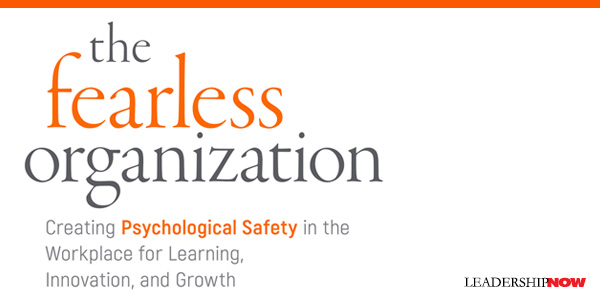
YOU’VE CAREFULLY put your team of people together, spent a lot of time getting the right people on the bus, your best and brightest, and yet you’re underperforming? Your team isn’t giving you everything they’ve got. People hold back when they feel it is not in their best interests to contribute—to say what they think. As a result of this interpersonal fear, we miss the benefit of the very minds we are relying on to move us forward. Creating psychological safety is essential in a world where innovation, integrity, and renewal can make the difference between success and failure. In The Fearless Organization, Amy Edmondson explains what psychological safety is and what it isn’t and how we can create in our organizations. We all—most of us—manage our image. Some better than others. But… No one wakes up in the morning excited to go to work and look ignorant, incompetent, or disruptive. These are called interpersonal risks, and they are what nearly everyone seeks to avoid, bit always consciously. In fact, most of us want to look smart, capable, or helpful in the eyes of others. No matter what our line of work, status, or gender, all of us learn how to manage interpersonal risk early in life. And it is this fear we have of looking bad or retribution that organizations must reduce or eliminate if we are to help people to bring their best to work. Psychological safety is not about taking all of the bumps and ruts out of the road (which sadly is becoming more and more prevalent in leadership thought today). Psychological safety is like the oil in the machine. It makes everything else you’re doing work better. It is an enabler. “Psychological safety makes it possible for other drivers of success (talent, ingenuity, diversity of thought) to be expressed in ways that influence how work gets done.” Without it, people will withhold thoughts, ideas, and contributions that are vital to your growth, renewal, and the overall health of your organization. It’s not about whistle-blowing. “Whistle-blowing is not a reflection of psychological safety but rather an indication of its absence.” Psychological safety is not about introverts or extroverts. It’s not about being nice. It’s not about creating an environment where people are talking all the time. You need discipline. The is to make it easy for everyone to get everything out on the table so that you can proceed in a thoughtful, calculated way. Psychological safety doesn’t mean sharing everything either. That doesn’t create a safe place to work. People will learn where to draw the line with constructive feedback. It’s an emotional intelligence issue. Psychological safety is not about lowering performance standards. It’s not an anything-goes environment. As the chart below shows, “psychological safety and performance standards are two separate, equally important dimensions—both of which affect team and organizational performance in a complex interdependent environment.
Psychological safety enables candor and openness and, as such, thrives in an environment of mutual respect. It means that people believe they can—and must—be forthcoming at work. In fact, psychological safety is conducive to setting ambitious goals and working toward them together. Psychological safety sets the stage for a more honest, more challenging, more collaborative, and thus also more effective work environment. One must build psychological safety to spur learning and avoid preventable failures, and they must set high standards and inspire and enable people to reach them. We owe each other our opinions and ideas, and it is the responsibility of leaders to create and reinforce an environment where people free to do that. Psychological safety is about unleashing talent across your organization. Creating a psychologically safe workplace is an ongoing function of leadership. Edmondson divides the process into three steps which she covers in detail: Setting the Stage, Inviting Participation, and Responding Productively. Setting the Stage This step is about framing the work to be done and how failure is to be dealt with. As GoogleX’s Astro Teller stated, “the only way to get people to work on big, risky things…is if you make that the path of least resistance for them [and] make it safe to fail. I’m not pro failure, I’m pro learning.” Inviting Participation Two mindsets are required here: situational humility and proactive inquiry. Humility is an obvious quality but not as easy to cultivate. Inclusiveness on the part of leaders helps in this regard. London Business School Profesor Dan Cable wrote, “Power…can cause leaders to become overly obsesses with outcomes and control,” inadvertently ramping up, “people’s fear—fear of not hitting targets, fear of losing bonuses, fear of failing—and as a consequence…their drive to experiment and learn is stifled.” No one feels safe presenting ideas to a know-it-all or someone who feels the need to be talking all of the time. Proactive inquiry is actively asking questions designed to learn more about an issue, situation, or person. We benefit from a diversity of views. Implement structures designed to elicit employee input. Responding Productively “It’s imperative that leaders—at all levels—respond productively to the risks people take. Productive responses are characterized by three elements: expressions of appreciation, destigmatizing failure,” and punishing clear boundary violations—reinforcing the rules of mutual respect.
There is a connection between psychological safety and learning. It’s foundational to building a learning organization. In an ever-changing world, learning and adaptability is everything. Edmondson admits that this is not an easy process. It’s not a natural process. Creating psychological safety is a constant process of smaller and larger corrections that add up to forward progress. Like tacking upwind, you must zig right and then zag left and then right again, never able to head exactly where you want to go and never quite knowing when the wind will change. It’s a necessary condition for success. What’s at stake is the future of our organizations. 
Posted by Michael McKinney at 03:28 PM
01.23.19

Newswire: Creative Artists Agency Managing Partner Rob Light
Posted by Michael McKinney at 09:35 PM
01.21.19

The 9 Dimensions of Conscious Success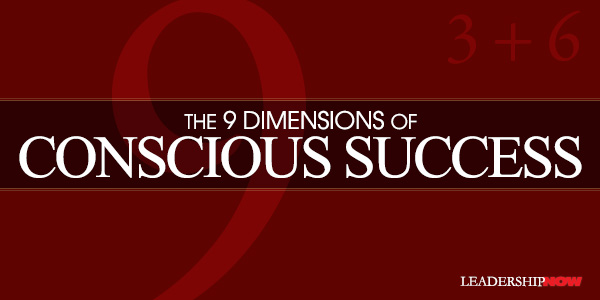
HOW DO YOU stand out in your chosen occupation to get the respect, recognition, and opportunities you want and deserve, to achieve the success you want? Leadership and life are built on relationships. Despite any talent or education you may have, your ability to work with and influence others is what will set you apart. But that doesn’t just happen. You need a plan. The 9 Dimensions of Conscious Success: It’s All About You! by David Nielson was written to give you a framework to consciously bring about your success. The foundation of the Conscious Success Model contains three critical elements: Your Purpose, Self-Awareness, and Social Awareness. Your Purpose Why am I here? Your reason for being is built around “an anticipated outcome that is intended or that guides your planned actions.” Having a stated purpose for your life helps to give you inner strength—an internal sense of control. You are not a victim. A specific purpose helps you also to align your actions to the purpose of others and your organization. Self-Awareness Self-awareness allows you to separate yourself from what’s happening around you to identify your thoughts, feelings, physical state, and belief systems. “Awareness precedes meaningful choice. It is nearly impossible to make good life choices with no self-awareness.” When you are aware of your inner state—where you are at—it makes it easier to act on purpose. A good place to get self-awareness is to watch the behavior of others. Often the behaviors that irritate you are mirrors of your own life. Social-Awareness How do you impact others? Before you interact with others, begin by asking what is the desired result based on who I am, my purpose, and who I want to be? We have an impact on everyone we meet. How do others perceive us? Is that our intent? Does it align with our purpose? The other part of the Conscious Success Model is how we differentiate ourselves. 3 Elements + 6 Differentiators = 9 Dimensions of Success. We cannot rely “on fate to be noticed. We have to be more proactive, more deliberate and consciously aware. This is conscious success.” Each of the differentiators is connected to and must be aligned with the three core elements. As we move to the differentiators, Nielson begins by asking, “How am I really showing up? How am I presenting myself to others? Am I having the impact I really want to make?” What value do I bring? This, of course, speaks to having a healthy self-awareness. Each of these differentiators as negative and a positive side. Either side will get you noticed. Avoid the side that will get you noticed for the wrong reasons.
Authenticity is “never deceiving yourself or others in how you show up.” It might go without saying but to be true to yourself you need to know who you are and what you stand for. We mostly lack authenticity because we are trying to be what people want us to be in order to be accepted or popular. We are inauthentic to cover up for our insecurities. Authenticity leads to trust. Consistency matters. Differentiator 2: Work Ethic and Personal Responsibility “Work with conviction to produce the results you desire and take responsibility for the results produced—even when they fail to meet the desired result.” A good work ethic is based not on time put in but on results achieved. If you want to differentiate yourself, “show up early for work, do more than you’re asked to do, do everything to the best of your ability, and if you finish your work, offer to help others.” Decide that you are 100 percent responsible for what happens in your life and everyone else is 0 percent responsible. It might seem unrealistic to do this but deciding to be 100 percent responsible forces you to move forward. “The reason the ratio must be 100 percent to 0 percent is that as long as the zero spot is occupied by any value, I can blame and justify the non-result. Blaming and justifying limits options and 100 percent to zero percent responsibility expands options.” Differentiator 3: Listening for Results and Connections “Concentrate intently on the words of others in such a way you could understand and repeat accurately what is said.” Listening shows respect for others and builds others trust in you. Ask questions with the intent of clarifying your understanding. Differentiator 4: Articulate for Impact Closely related to differentiator 3 on listening is articulation. “Provide information in a clear, concise way which produces the desired impact.” To be always talking doesn’t make you look smarter. Have a good vocabulary. Before you speak, consider your emotional state. Also, think about what your purpose is and what you are trying to convey. Differentiator 5: Humor Humor is “looking for and appreciating the humor all around us and even being able to laugh at one’s self.” Humor can provide perspective. Smile. “Facial expressions do not merely signal what someone feels but actually contribute to that feeling. If we smile even when we don’t feel like it, our mood will elevate despite ourselves.” Use humor appropriately. “Be sure the style and content of your humor is consistent with your purpose and brand. You can have a sense of humor, but it must be consistent with your image and what it is you want to accomplish.” Differentiator 6: Gratitude “Make the choice to be thankful for what you have and consciously demonstrate gratitude when others do something for you.” I believe that a lack of gratitude can undo all of the other differentiators. Gratitude is a choice we make each and every day. Having an attitude of gratitude gives you a positive outlook which makes you more attractive to others. Conscious Success as the label implies doesn’t happen by accident. It takes commitment, focus, and a force of will. The Conscious Success Model provides a useful framework for not only differentiating yourself but creating a life that matters. The 9 Dimensions of Conscious Success is a great tool to put into the hands of anyone starting out in life. 
Posted by Michael McKinney at 11:06 PM
01.18.19

The Truth About You
IN THE January/February 2019 issue of Communication Arts, Ernie Schenck writes about two kinds of truth: authentic and inauthentic. Authentic truth is who you are. Inauthentic truth is who you are when everyone is looking. It’s accepting what the loudest voices around you are saying because you don’t want to look bad. It’s commonplace in politics, but we see it everywhere. It’s pandering. Not leadership. It’s denigrating. Not serving. Inauthentic leadership is selfish. We use it to get something. To get us from A-to-B. As leaders, we need to be sure we are walking our talk. If we talk about service to others, then everything we do must be guided by that value. If we believe in building others, then everything we do must build others without regard for our own position. If we are empathetic, then our criticisms are constructive and measured, not strident. The alignment between who we are—our authentic truth—and what we say and do is critical. A leader who acts or his or her authentic truth is a leader that can be trusted. If we jump on every bandwagon that comes through, we can be perceived as not knowing our own mind. When we lead from who we are and not from where everyone else thinks we should, more than just being trusted, we can more easily adapt, grow, and lead in a thoughtful and measured manner. Here are Schenck’s thoughts on truth in advertising from The Truth Is Out There. Kind Of.: The authentic truth. It’s absolute. It’s unshakeable. Its power to propel us as creatives mighty beyond measure. But there is another truth. It is feeble. It is disingenuous. And it is something we’ve rarely seen before. The kind of truth that’s fleeting. Fabricated. Cloaked in insincerity. And if we’re not careful, it can lure us onto a bandwagon that at best is uncomfortable and at worst can suck the spirit out of us. Call it the inauthentic truth.
Posted by Michael McKinney at 01:25 PM
01.16.19

Conquering the 5 Misconceptions that Hold Leaders Back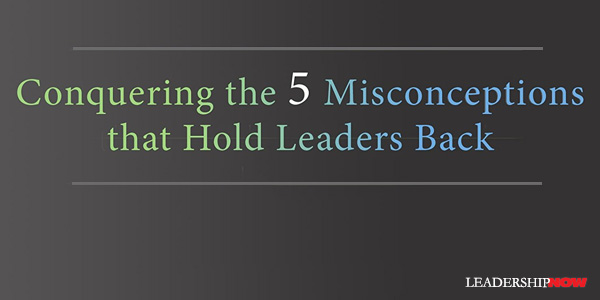
THERE ARE THINGS we believe that when we really think about them, we might find that they are not helpful. We might think of them as blind spots that adversely affect our leadership effectiveness. In What Are Your Blind Spots? Jim Haudan and Rich Berens hope to help you uncover five common leadership blind spots by exposing the underlying assumptions behind the consequences we see played out over and over again in all types of organizations. This is how they lay it out: Leadership Blind Spot #1: Purpose The Misconception: Purpose matters, but it doesn’t drive our numbers. An organization primarily focused on the hitting the numbers is a push mentality. To focus on the purpose is a pull strategy. A firmly ingrained purpose has the power to pull the numbers we are seeking. At the same time, it is nimble and responsive to changing circumstances as it is attached to a point of view and not a procedure. They note: Organizations with a strong purpose at their core are more likely to be able to change when they truly need to. They will view their current operating model and customer offerings as merely a means to achieve their larger purpose and should, therefore, be able to change direction more easily when market forces require a more radical shift. Leadership Blind Spot #2: Story The Misconception: We have a compelling story to tell that people care about. If you have a clear purpose, there is usually a good story behind it. Stephen Denning wrote in Telling Tales, “Analysis might excite the mind, but it hardly offers a route to the heart. And that is where we must go if we are to motivate people not only to take action but to do so with energy and enthusiasm.” The truth is that to reach the heart, you have to create a sense of adventure and a sense of belonging, while also outlining a meaningful journey where people can see how their contributions make a difference. Leadership Blind Spot #3: Engagement The Misconception: Rational and logical presentations engage the hearts and minds of people. We can’t present our way into the hearts and minds of people. The authors suggest that we connect with others with relationships that inspire hope. We contribute disengagement and stifle inspiration. Through authentic conversations, we can co-create with our employees. “We simply suggest,” they write, “that leaders repeat their own personal thinking journey with their people.” Invite people to co-think with you. Inviting your people to help you solve the problems of your business begins with leaders believing in the immense creation capability of their people. Shifting your thinking from “I am the creator, and my people are the implementers” to “I know this business well, but so do my people, and I can learn from them if I really listen” will transform your organization. Leadership Blind Spot #4: Trust The Misconception: People will not do the right thing unless you tell them what to do and hold them accountable to do it. With the first three blind spots exposed and conquered, trust becomes much easier. People know what to do and why they are doing it. Rigid controls are counterproductive, and standards become easier to maintain. They become agents of the vision. To this point: People must believe it’s their store, their hotel, their office, their factory, or their hospital. They must feel that they’re more than a cog in a wheel with overseers watching and waiting to catch them in a screw-up. They note, “It’s the job of the leader to invite that uniqueness to be a part of the work experience every day.” That only happens when we stop controlling our people and trust them and their judgment. Leadership Blind Spot #5: Truth The Misconception: My people feel safe telling me what they really think and feel. I think it is safe to say the people don’t always feel comfortable speaking truth to others especially superiors. For any leader, it’s safer to assume that they don’t and make a conscious effort to create a culture where people will feel safe to come to you with the truth even if it’s just the truth as they see it. Humor helps to break the ice. Truth is a critical blind spot that can create an environment of poor decision making mixed with a significant lack of trust and disengagement in your organization. What Are Your Blind Spots? is a short but well thought out book. Inside you will find an assessment to help you see where you stand on each of these issues as well as exercises and tools to help you conquer each of them. 
Posted by Michael McKinney at 09:56 PM
01.14.19

Unlocking Creativity: Are These Creativity-Inhibiting Mindsets Holding You Back?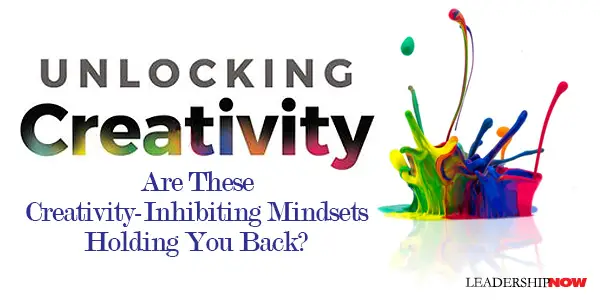
IN AN IBM global survey of CEOs, the overwhelming consensus was that more than rigor, management discipline, integrity or even vision, successfully navigating an increasing complex world will require creativity. In a world where we must adapt or die, we need creative solutions. In struggling to generate a sufficient number of creative ideas, we typically blame the number of creative individuals in our organization or hierarchy and bureaucracy. But in Unlocking Creativity, Michael Roberto takes a different perspective. He believes that we are getting in our own way by the way we think, decide, and act with regard to the development of original ideas. We find that while we talk about the need for creativity and innovation, employees don’t feel supported or inspired by their leaders and were not given the time or resources to develop new ideas. And there seems to be a stigma surrounding creative types. There often viewed as quirky, unfocused, strange, and nonconformist. As a result, they are viewed as having less leadership potential. Isaac Asimov once said, “The world, in general, disapproves of creativity, and to be creative in public is particularly bad. Even to speculate in public is rather worrisome.” The question is, do we have a people problem or do we have a situation problem? Roberto looks at six organizational mindsets or belief systems that stifle creativity. The Linear Mindset “Many organizations fail to understand and embrace the discontinuous nature of the creative process.” They expect disciplined execution—on time and under budget. But realistically, creativity is not like that. The creative problem-solving process involves a healthy dose of trial and error. We must learn by doing. Many companies have failed to make the shift from the traditional planning mindset to a learning-by-doing approach. Strategy formulation and implementation remain largely disconnected from one another. Firms continue to engage in annual strategic-planning rituals, pretending that they can predict the future from the confirms of the corner office. Even worse, they have treated design thinking as just another linear process that they can deploy. Step two always follows step one. They march through the phases robotically, as if they have discovered a magic formula for innovation. But the five stages of design thinking are not always sequential as Roberto explains. “Trying to turn any creative process—design thinking or otherwise—into a highly structured, linear system turns out to be a colossal mistake.” The Benchmarking Mindset “Firms study their competitors closely, but in so doing, they experience fixation. Consequently, they adopt copycat approaches rather than creating distinctive strategies.”
Firms should recognize that differentiation comes from becoming more lopsided rather than well rounded. You establish a distinctive competitive position by amplifying your strengths, rather than engaging in knee-jerk efforts to imitate your competition. We often fixate on what we know. “We become attached to a specific mental set, a way of thinking about a problem based on solutions that have worked in the past. Mental sets can facilitate problem-solving at times, but becoming fixated on an inappropriate solution from past experience can inhibit creativity.” One way to avoid this fixation is to learn from people outside of our industry. “Rather than simply benchmarking direct rivals, companies need to think broadly about the full range of substitutes against which they compete. American Airlines competes against Skype and WebEx, not just Delta and United.” Avoiding this mindset takes courage. “When you chose not to imitate, you often make bold bets that may lead to failure.” And “In many instances, people do not recognize the merits of the distinctive, creative strategy at first.” It’s easy to just go back to what you know and are comfortable with. The Prediction Mindset “Managers have a desperate desire to see what’s next and they exhibit overconfidence in the ability of experts to forecast the future. The insatiable need to predict just how big ideas will become actually impedes creativity.” We crave certainty. When it comes to forecasting “How people think matters more than what they already know.” The best forecasters are intellectually curious gathering information from a wide variety of sources and updating their conclusions as the facts change. The prediction mindset impedes creativity because of the way new ideas are treating in most organizations. We support and fund ideas that we think are going to be the next big thing—move the needle. The problem is we don’t really know. And some great ideas need time to ripen and be modified as they are tested in the marketplace. Focus not on the short-term return but on delighting customers. “Managers often resort to changes in organizational structure as a means of stimulating creativity and improving performance.” Here’s the bottom line we can learn from example after example: “Leaders will not find an optimal structure that unleashes creativity. No such perfect solution exists. You cannot find a simple causal path that connects structure to performance.” Instead, “the best leaders pay close attention to team climate (psychological safety), behavioral norms and ground rules (rules of engagement), and the design of the work itself (personal responsibility).” These elements allow creativity to flourish. The Focus Mindset “Organizations believe that teams will excel at creative work if they focus intensively, perhaps even secluded from their colleagues. They fail to recognize that the best creative thinkers oscillate between states of focus and unfocus.” Focus and distance. Srini Pillay wrote in the Harvard Business Review, “The brain operates optimally when it toggles between focus and unfocus, allowing you to develop resilience, enhance creativity, and make better decisions too.” Creating that space can be done by simply walking at times, but with teams consider having team members role-play different roles than they currently occupy. Travel helps to spark creativity as does creating temporal distance.
Jeff Bezos and the people at Amazon use “time travel” frequently to stimulate innovative thinking about new products and services. Andy Jassy, Senior Vice President of Amazon Web Services, explains that developers in his organization do not begin writing software code for a new project until they have drafted a hypothetical release for their new product offering. The Naysayer Mindset “Managers encourage people to critique each other’s ideas early and often. Unfortunately, the failure to manage dissent and contrarian perspectives constructively causes many good ideas to wither on the vine.” The Devil’s Advocate technique can be helpful but with ground rules: the who, when, and how of devil’s advocacy. If the role is always played by one person, they begin to be ignored. So rotate the role. Because of the pressure to conform, Roberto recommends having two devil’s advocates. It must be constructive and respectful. As in with President John Kennedy during the Cuban Missile Crisis, he assigned Theodore Sorensen and Robert Kennedy to “relentlessly pursue every bone of contention in order to prevent errors arising from too superficial an analysis of the issues.” The idea is to provoke dialogue and debate. Creating an environment that unlocks the creativity inherent in your organization is not easy nor can you expect immediate results. “Remember that the creative capabilities of people throughout your organization may have lain dormant for quite some time.” See the process through their eyes. It is the calling of leaders. “Enabling others to explore, experiment, learn, and create is your duty as a leader, and it’s potentially the most rewarding work you will ever do.” Unlocking Creativity is well written and engaging as Roberto pulls lessons from numerous studies and a wide variety of people and organizations like Leonardo da Vinci, IDEO, U2, Google, the Beatles, Amazon, Israeli Intelligence, Zappos, Google, NASA, Pixar, Data General, Hollywood, Disney, Trader Joes, Reebok and Planet Fitness. Unlocking Creativity pulls together what we know about creativity and how that knowledge can be applied to our organizations and teams to foster innovation. 
Posted by Michael McKinney at 11:46 PM
01.09.19

How to Win in Africa
IN THE WESTERN WORLD, we often do not have an accurate picture of Africa as a growing marketplace. We frequently imagine a continent of villages and stories of corruption and violence dominate our perspective. Authors Acha Leke, Mutsa Chironga and Georges Desvaux of McKinsey and Company, take a different view in Africa’s Business Revolution. They say business leaders tend to “underestimate Africa’s size and potential as a market, and overestimate the challenges of doing business there.” There are one-hundred companies with annual revenues of a billion dollars or more. In the next 20 years, 80 percent of its population growth will occur in cities. And technology? “This young continent, with a median age of around twenty, is an eager adopter and innovator in all things digital and mobile.” Africa is the next growth market. The authors believe that companies and investors in every part of the world should take a look at Africa and its place in their long-term growth strategy because Africa is a 1.2-billion-person market in the midst of a historic economic acceleration, it has a huge unfulfilled demand, making it ripe for entrepreneurship and innovation at scale. They compare Africa to China 25 years ago. Would it have made sense for your company to get into China then? Now is the time. They present five trends that are not without their challenges which they explore in detail:
Determining a strategy is the real trick. To win in Africa, your strategy needs to factor four key considerations: Map an Africa Strategy: Africa is huge. It will be important to pinpoint those areas where you can create an ecosystem to thrive in. Part of that ecosystem should include local partners who understand the lay of the land. “You will have to dispense with generalizations, and truly understand the differences in countries’ wealth, growth, and risk profiles.” Create Innovative Business Models: “To profitably serve African customers in meaningful numbers companies need to build high efficiency and low cost into their business models.” High volumes—low margins—cost-effective—technology-driven. Building Resilience for the Long Term: A long-term view will be necessary to ride out short-term volatility. It will be essential too, to diversify by building a balanced portfolio across countries or sectors. They also recommend integrating up and down your value chain to ensure reliable access to inputs (including what would usually be outsourced). Build relationships with relevant governments to be sure your voice is heard. Unleash Africa’s Talent: Invest in people. Skill shortages are a major concern for a number of reasons but primarily Africa’s underperformance in education. Subway has found that most applicants “don’t know what it means to have a full-time job and don’t understand the standards we demand here.” Turnover is high. Training for entry-level and frontline employees is essential. Develop programs to grow talent from within and make gender diversity a priority. Africa’s successful business leaders are driven by a deeper purpose. “They look at Africa’s high levels of poverty; its gaps in infrastructure, education, and health care; and its governance problems, and they don’t just see barriers to business, but human issues they feel responsible for solving.” But then that’s what real leaders do. They have empathy, and they take responsibility. “To be successful, you need to be more than a businessman—you need to be a responsible citizen.” Importantly, the solutions companies find to succeed in Africa, could also be hugely beneficial in terms of efficient products, services, and business models for the rest of the world. 
Posted by Michael McKinney at 11:50 PM
01.07.19

What’s Your Story?
WHAT GREAT LEADERS have in common is their ability to communicate and create meaning from their words. Much of that ability speaks to the ability to listen and read between the lines to develop an understanding with those you lead. Great stories begin with great listening. From there, you can learn how to connect your perspective to theirs. Leaders are in a different place from those they lead. A story that is large enough that it aligns with their values inspires them to make the journey to where you are. This is especially important today when ironically, our ability to communicate in a meaningful way is deteriorating. The structures we used to have to develop that skill are diminished. Bursts of thought do not help to create the empathy we need to function effectively as a civilization. We don’t connect in bursts of thought but in shared stories. A good story can set the tone for a deeper connection and empathy for another’s perspective. In a September 2018 interview with Fast Company magazine, Doris Kearns Goodwin talks about her book, Leadership: In Turbulent Times, and the ability of the four presidents she delved into to communicate through stories. Each of the presidents she portrays could help their audience see themselves in the future they were describing. A well-crafted story has the power to give the audience ownership of the idea that is woven into the story. Goodwin is asked, “What’s the most important lesson that business leaders can take from these presidents?” If I were to pick one, it would be the ability to speak to audiences with stories. [Take] Abraham Lincoln: While we celebrate his beautiful language, his speeches really worked because they were filled with stories and illustrations. He believed people remembered anecdotes better than facts and figures. When he was young, he would listen as his father, and the people who would come by his little log cabin told stories. He’d go to bed at night and try to translate those stories into [his] words, so he could then go out on the field the next day, stand on a tree stump—he’s like eight, nine years old—and entertain his friends. Goodwin adds this about Theodore Roosevelt’s ability to relate—even today: What really interests me is thinking about which of these [presidents] would give a speech that would be relevant today. It would probably be Teddy Roosevelt. Think about where we were at the turn of the 20th century: The industrial revolution had shaken up the economy, immigrants were pouring in, cities were replacing towns. A gap was developing between the rich and the poor, and the social landscape was changing because of all these new inventions: the automobile, the telegraph, and the telephone. You had populist movements that called for restrictions on immigration, and the establishment worried about [giving] power to ordinary people. Ryan Matthews and Watts Wacker begin their book, What’s Your Story? with this observation: “Long before the first formal business was established, before the first deal, the six most powerful words in any language were Let me tell you a story. What’s your story?
Posted by Michael McKinney at 12:03 AM
01.03.19

Newton’s First Law and Your Life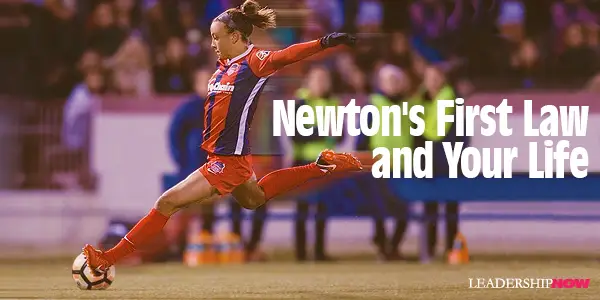
IN 1686, Sir Isaac Newton presented three laws of motion. The first law is often referred to as the Law of Inertia. The law states that every object will remain at rest or continue in a straight line unless compelled to change its state by the action of an external force. In other words, things stay the way they are unless something comes along to disrupt them. This law has the power to make us or break us. And it is at work in our lives all day, every day whether we are conscious of it or not. When we kick a soccer ball, it heads in a specific direction until it is acted upon by a force greater than the force that is currently propelling it downfield. Like that soccer ball, our life is moving along a path that is taking us to a particular future intentionally or not. And we will continue along that path to its destination until we do something different. It’s not about what we want. It’s about what we are doing. Our intentions mean nothing. It’s a law, and as such, it is objective and indifferent to our intentions. In other words, our 2019 will be just like our 2018 unless we exert a force to change our direction that is greater than comfort we enjoy by continuing to do what we have always done producing the same results again and again. No force, no change. 2019 will be 2018 all over again. If you’re not where you want to be, change your direction. Get on a new path. New actions will produce different results. We can use Newton’s law to our advantage. For every cause, there is an effect. Today is connected to tomorrow. Every action we take and everything we say is taking us somewhere. We just need to be sure we are on the path that is taking us where we want to go; a path that is taking us to the person we want to become. If we work harder than we did last year, then we will do better.
If we don't improve, then our circumstances won't improve either. We can’t tell ourselves that it’s not going to be alright if we are headed in the wrong direction. Life naturally pushes us off-course and takes us on tangents. Anything meaningful in life is produced by moving upstream – against the current. When we find ourselves where we don’t want to be, we must acknowledge the fact that we have drifted; we have gone with the flow. We need to make some course corrections. We all do from time to time. Of course, this implies getting uncomfortable. It’s helpful to have a mentor, a coach, or a program that will keep us accountable, because we tend to say, “I pushed hard enough” when we’ve barely touched our potential. As we look at our life, we all have directions that need to be changed. It helps to begin this process by asking ourselves questions and giving serious and honest thought to the answers. The big general questions are: What worked for me last year and what didn’t? What habits are holding me back? What three things do I want to accomplish by 2020? What is that one thing I need to accomplish in 2019—your BHAG—my Big, Hairy, Audacious Goal? What does a good day look like? What routines keep me on track? Why do I do what I do? And most importantly, what am I grateful for? Then drill down into specific areas of your life: Do I make time to study and grow spiritually?
The key to moving forward is the first step. Every destination needs to be broken down into incremental markers or indicators on the way to the destination. What is the first thing you need to do to get you moving in the right direction? As you begin, focus on the actions required and not the end result. A small step is easier than a leap. Once the first step is made, it is easier to continue down the right path to your desired destination.
Posted by Michael McKinney at 12:34 AM
01.01.19

First Look: Leadership Books for January 2019Here's a look at some of the best leadership books to be released in January 2019. Don't miss out on other great new and future releases.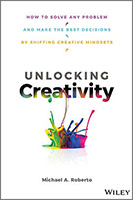 Unlocking Creativity: How to Solve Any Problem and Make the Best Decisions Unlocking Creativity: How to Solve Any Problem and Make the Best DecisionsMichael A. Roberto Leaders do not have to conceive innovative ideas, but rather open the path for curious and creative employees within their organization. Unlocking Creativity aids organizations in removing obstacles to the creative process and helps to form an atmosphere of imagination and innovation. 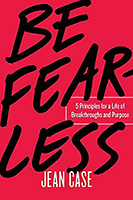 Be Fearless: 5 Principles for a Life of Breakthroughs and Purpose Be Fearless: 5 Principles for a Life of Breakthroughs and PurposeJean Case When National Geographic Chairman Jean Case set out to investigate the core qualities of great change makers, past and present, from inventors to revolutionaries, she found five surprising traits all had in common. They weren’t wealth, privilege, or even genius. It was that all of these exceptional men and women chose to make a “big bet,” take bold risks, learn from their failures, reach beyond their bubbles, and let urgency conquer fear. 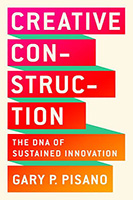 Creative Construction: The DNA of Sustained Innovation Creative Construction: The DNA of Sustained InnovationGary P. Pisano The conventional wisdom is that only disruptive, nimble startups can innovate; once a business gets bigger and more complex corporate arteriosclerosis sets in. Big organizations require a different set of management practices and approaches—a discipline focused on the strategies, systems and culture for taking their companies to the next level. 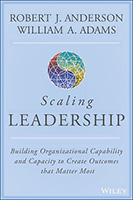 Scaling Leadership: Building Organizational Capability and Capacity to Create Outcomes that Matter Most Scaling Leadership: Building Organizational Capability and Capacity to Create Outcomes that Matter MostRobert J. Anderson and William A. Adams Is your leadership built for scale as you advance in today’s volatile and disruptive business environment? This context puts a premium on a very particular kind of leadership—High-Creative leadership capable of rapidly growing the organization while simultaneously transforming it into more agile, innovative, adaptive and engaging workplace. 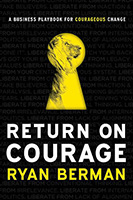 Return on Courage: A Business Playbook for Courageous Change Return on Courage: A Business Playbook for Courageous ChangeRyan Berman Return on Courage is the go-to courage instructional manual that helps readers attack and shrink business fears head-on. They will learn how to relentlessly play offense, drive change, and transform into a Courage Brand®. ROC can be the secret weapon to innovating new products and services, maximizing ROI, and revolutionizing their industry. 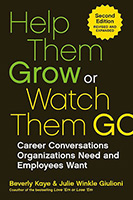 Help Them Grow or Watch Them Go: Career Conversations Organizations Need and Employees Want Help Them Grow or Watch Them Go: Career Conversations Organizations Need and Employees WantBeverly Kaye and Julie Winkle Giulioni Study after study confirms that career development is the single most powerful tool managers have for driving retention, engagement, productivity, and results. But most managers feel they just don't have time for it. This new edition offers a better way: frequent, short conversations with employees about themselves, their goals, and the business that can be integrated seamlessly into the normal course of business.  Build your leadership library with these specials on over 39 titles. All titles are at least 40% off the list price and are available only in limited quantities. “Books, because of the power they possess to exert intellectual influence, more so than any other form of serious communication, change the way readers — and even leaders — see the world and set the stage for them to change it.” — Peter J. Dougherty, editor-at-large at Princeton University Press
Posted by Michael McKinney at 02:05 AM
|
BUILD YOUR KNOWLEDGE


How to Do Your Start-Up Right STRAIGHT TALK FOR START-UPS 
Grow Your Leadership Skills NEW AND UPCOMING LEADERSHIP BOOKS 
Leadership Minute BITE-SIZE CONCEPTS YOU CAN CHEW ON 
Classic Leadership Books BOOKS TO READ BEFORE YOU LEAD |
|